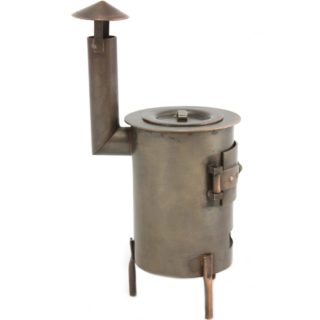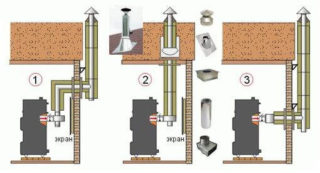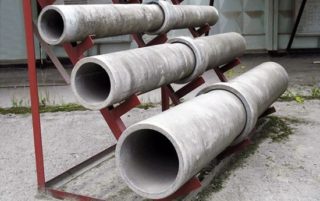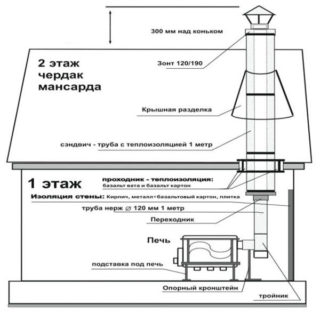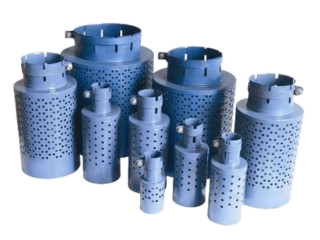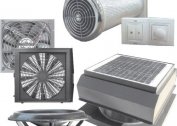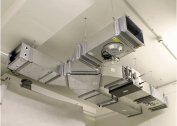Small portable stoves are an excellent solution for heating garages, greenhouses in dachas, utility buildings, where people are not constantly. It is important to correctly build a chimney for the stove, creating conditions under which the combustion products are completely removed from the room. The installation of the chimney can be done on its own, having made the structure of inexpensive materials.
Features of the operation of a solid fuel furnace
The stove-potbelly stove is not suitable for heating residential premises as the main heat source due to increased fuel consumption, the need for constant monitoring of functioning and the addition of a new portion of firewood.
The main purpose of the device is to heat small rooms when there is a person who monitors work.
The principle of operation of any stove is based on the burning of solid fuel and the transfer of heat to the room.
Combustion products are poisonous, carbon monoxide poisoning is deadly. The stove and chimney are heated to high temperatures, which can cause burns or fires.
When operating the furnace, the following conditions must be met:
- high-quality ventilation of the room and the influx of fresh air to maintain fuel combustion;
- sealed pipe that prevents leakage of toxic gases;
- Avoidance of objects made of combustible materials near the stove and chimney:
- reliable thermal insulation of building structures.
All these conditions must be observed in the design and manufacture of the chimney.
Chimney laying methods
Often, potbelly stoves are installed outdoors and used for cooking, steaming feed for farm animals, and heating water. In this case, a chimney of suitable diameter is used for the chimney. It is important to choose a channel above human growth - smoke will not irritate the mucous membranes, and draft will be enough to maintain fire and exhaust combustion products.
Chimneys for bourgeois in garages and saunas are organized according to other schemes:
- The channel is vertically led out through the ceiling. Most of the chimney is located indoors and gives off heat, thereby increasing energy efficiency. At the same time, the method places increased demands on the thermal insulation of transition points through building structures to prevent fires. To protect against leakage during rain and snow, you need to make a roof waterproofing.
- The chimney with a horizontal elbow is led out through the wall in the immediate vicinity of the potbelly stove, and the main pipe runs vertically through the building. A small section of the pipe indoors gives off little heat, but is most fireproof.
- The best option is the chimney outlet through the wall at a distance of about half a meter from the ceiling. In this case, the channel warms up the room, but there is no need to make a hole in the ceiling and roof, which reduces the monetary and time costs of manufacturing.
The rules for arranging chimneys prohibit the use of horizontal sections of more than one meter long for the removal of combustion products. From a vertical plane, deviation by an angle of not more than 30 degrees is allowed.
Requirements are taken into account when choosing the installation location of the stove in the room. In addition, it is forbidden to arrange more than 3 turns of the channel throughout.
Materials for the manufacture
For the manufacture of chimneys for stationary furnaces used for the main heating of buildings, SNiP 41-01-2003 allows the use of refractory bricks, heat-resistant concrete and a stainless steel panel sandwich.
For the potbelly stove these requirements are excessive, the price of materials will many times exceed the cost of the furnace itself. In addition, one of the main advantages of a potbelly stove will be lost - heat transfer to the surface of the chimney.
In practice, metal or asbestos-cement pipes are used. The metal channels heat up quickly, but a hot surface can cause burns. It is advisable to install a screen or enclosure.
The pipes are positioned so that there is a distance of at least 250 mm from the combustible surface of the walls. If necessary, heat-reflecting screens are made or thermal insulation materials are laid. For pipes, stainless steel or alloyed metal with a thickness of at least 0.6 mm is used. The wall thickness of the ferrous metal channel cannot be less than 3 mm.
Asbestos cement withstands temperatures no higher than 250 aboutC, and when heated above this limit, it collapses, sometimes with an explosion. Asbestos-cement pipes are used for the manufacture of the channel at a distance of at least 1 m from the outlet of the furnace. For the connection using metal adapters of suitable diameter.
Recently, the industry offers products for chimneys made of ceramics, glass, heat-resistant polymers. The cost of finished products is high, such exotic is rarely used to connect a potbelly stove.
Installation sequence
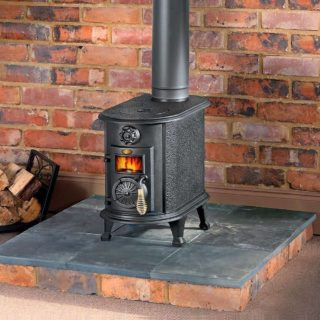
The installation sequence is approximately the same for any option for laying the chimney.
Seat selection
The place for the stove is chosen, taking into account the configuration of the future chimney - the minimum length is horizontal segments and no more than 3 turns.
Compliance with simple conditions will provide the necessary traction in any weather.
Take into account the method of laying pipes, which will require the manufacture of holes in the wall or partial disassembly of the ceiling and roof.
It is allowed to connect one potbelly stove to one chimney - this also affects the choice of place. In large rooms, choose the middle of the room and the wall, where it is easier to make a hole for the chimney.
According to the rules, the surface of the walls and ceiling should not heat above 45 aboutC. Choose a suitable distance to the building envelope or provide a margin for laying a heat insulator.
Measurement and calculation of chimney parameters
On factory stoves, the manufacturer makes the required diameter of the outlet for combustion products. Based on it, pipes of suitable sizes are selected.
If the stove is home-made, the diameter of the pipe is easy to calculate: the internal D of the pipe in mm = the volume of the combustion chamber in liters x 1.27. Example: stove volume 50 liters. 50x1.27 = 135. The inner diameter of the pipe should be at least 135 mm.
According to the measurements, determine and acquire the required number of knees, turns, tees. The top of the pipe is protected with a cap or deflector to prevent the ingress of sediment.
In the calculations, it is taken into account that the pipe should protrude at least 50 cm beyond the edge of the ridge, and for flat roofs it is necessary to indent more than 1.5 m from the coating.
For the bath, you can purchase or make your own water heat exchanger, which is placed on top of the pipe.
The protection of the places of passage through the walls or ceiling is performed with an asbestos cord or material.
Assembly of parts
Pipe installation work starts from a potbelly stove.
Sequencing:
- The first knee is put on the nozzle of the furnace and fixed with clamps. For reliability make an additional mount to the wall.
- After measuring, make a technological hole in the wall or ceiling, with a diameter 40 mm wider than the pipe.
- Knees and turns of the necessary size are selected and mounted.
- In places of passage through building structures, they arrange home-made or install purchased grooves.
- Pipes are attached to the walls in increments of 1 meter.
Mount the knee using the “smoke” method - the bell of the next part is put on to narrow the previous one. Smoke in this case is freely removed into the atmosphere.
For reliability and additional protection against leakage of combustion products, the joints of the elbows and turns are treated with a heat-resistant sealant.
Thick-walled pipes are connected by welding.
The edge of the pipe is protected with a cap or spark arrestor.
Trial firebox
After all the parts are assembled, the first heating is carried out. At the stage, places of smoke leaks are identified, which eliminate. With insufficient draft lengthen the chimney pipe - make it higher.
The last stage of installation is the heat and waterproofing of walls, ceilings, and roofs.
Construction Service
At each furnace, smoke leaks are identified and, if necessary, eliminated, which can occur during depressurization of joints or during burnout of a pipe.
Inspection is carried out at the very beginning of the furnace - cold smoke is painted white and is clearly visible. As the furnace and the channel warm up, the combustion products become colorless and difficult to distinguish.
It is strictly forbidden to operate the furnace with a detected leak. Especially in garages - carbon monoxide is heavier than air and accumulates in inspection pits. Exposure to the body occurs imperceptibly and often causes severe poisoning.
If cravings deteriorate, the cause is carbon deposits on the inner walls. More often soot accumulates in the winter, when condensation forms inside the pipes.
As necessary, the chimney is cleaned:
- mechanically - with brushes;
- burning special smoke bombs from soot.
The reason for the decrease in draft in winter and with rare fire chambers may be an ice plug in the area of the chimney head, which must be removed. It is easier to do this by melting the oven until the ice is completely melted.
It is not difficult to make and install a chimney for a potbelly stove. For any furnaces, the manufacturer offers ready-made accessories. For experienced craftsmen it is not difficult to make a chimney out of a metal pipe, which will save money. The correct gas exhaust channel will quickly warm up the room and will not cause accidents.
